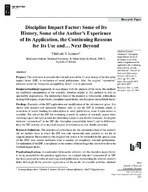| dc.contributor.author | Lazarev, V. S. | en |
| dc.coverage.spatial | Польша | ru |
| dc.date.accessioned | 2020-08-12T12:39:47Z | |
| dc.date.available | 2020-08-12T12:39:47Z | |
| dc.date.issued | 2020 | |
| dc.identifier.citation | Lazarev, V. S. Discipline Impact Factor: Some of Its History, Some of the Author’s Experience of Its Application, the Continuing Reasons for Its Use and… Next Beyond / V. S. Lazarev // Journal of Data and Information Science. – 2020. – Vol. 5, № 3. – P. 197-209. | en |
| dc.identifier.uri | https://rep.bntu.by/handle/data/77540 | |
| dc.description.abstract | Purpose: This work aims to consider the role and some of the 42-year history of the discipline impact factor (DIF) in evaluation of serial publications. Also, the original “symmetric” indicator called the “discipline susceptibility factor” is to be presented. Design/methodology/approach: In accordance with the purpose of the work, the methods are analytical interpretation of the scientific literature related to this problem as well as
speculative explanations. The information base of the research is bibliometric publications dealing with impact, impact factor, discipline impact factor, and discipline susceptibility factor.
Findings: Examples of the DIF application and modification of the indicator are given. It is shown why research and university libraries need to use the DIF to evaluate serials in conditions of scarce funding for subscription to serial publications, even if open access is available. The role of the DIF for evaluating journals by authors of scientific papers when choosing a good and right journal for submitting a paper is also briefly discussed. An original indicator “symmetrical” to the DIF (the “discipline susceptibility factor”) and its differences from the DIF in terms of content and purpose of evaluation are also briefly presented.
Research limitations: The selection of publications for the information base of the research did not include those in which the DIF was only mentioned, used partially or not for its original purpose. Restrictions on the length of the article to be submitted in this special issue
of the JDIS also caused exclusion even a number of completely relevant publications. Consideration of the DIF is not placed in the context of describing other derivatives from the Garfield impact factor.
Practical implications: An underrated bibliometric indicator, viz. the discipline impact factor is being promoted for the practical application. An original indicator “symmetrical” to DIF has been proposed in order of searching serial publications representing the external research
fields that might fit for potential applications of the results of scientific activities obtained within the framework of the specific research field represented by the cited specialized journals. Both can be useful in research and university libraries in their endeavors to improve
scientific information services. Also, both can be used for evaluating journals by authors of scientific papers when choosing a journal to submit a paper.
Originality/value: The article substantiates the need to evaluate scientific serial publications in library activities—even in conditions of access to huge and convenient databases (subscription packages) and open access to a large number of serial publications. It gives a mini-survey of the history of one of the methods of such evaluation, and offers an original method for evaluating scientific serial publications. | en |
| dc.language.iso | en | ru |
| dc.publisher | De Gruyter Open Ltd. | en |
| dc.title | Discipline Impact Factor: Some of Its History, Some of the Author’s Experience of Its Application, the Continuing Reasons for Its Use and… Next Beyond | en |
| dc.type | Article | ru |

